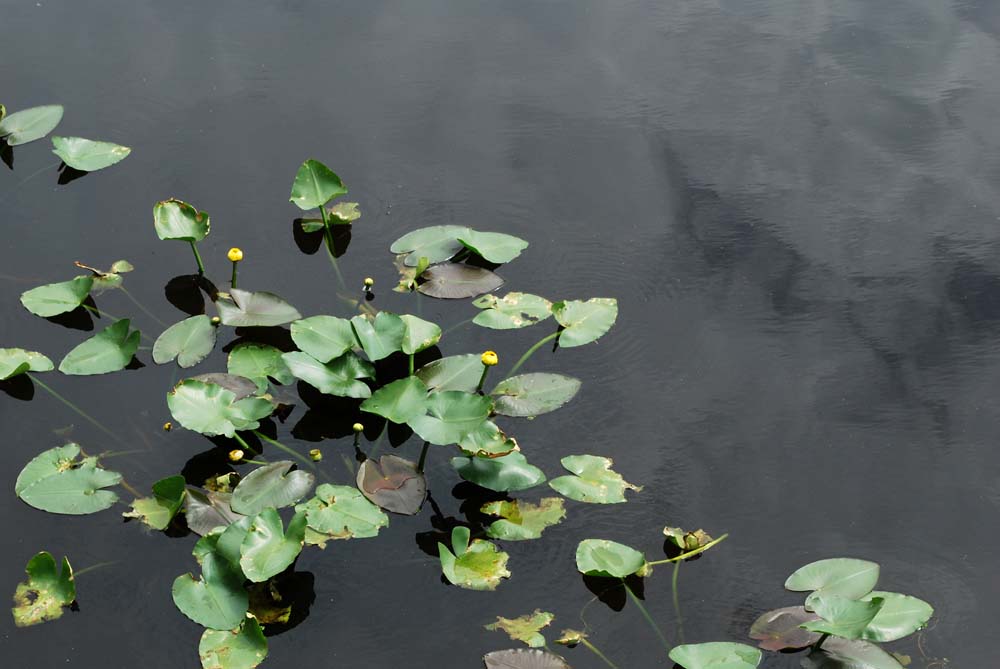Difference between revisions of "Nuphar advena"
KatieMccoy (talk | contribs) |
KatieMccoy (talk | contribs) |
||
| Line 33: | Line 33: | ||
===Phenology=== <!--Timing off flowering, fruiting, seed dispersal, and environmental triggers. Cite PanFlora website if appropriate: http://www.gilnelson.com/PanFlora/ --> | ===Phenology=== <!--Timing off flowering, fruiting, seed dispersal, and environmental triggers. Cite PanFlora website if appropriate: http://www.gilnelson.com/PanFlora/ --> | ||
Flowers May through November and fruits in September (FSU Herbarium). | Flowers May through November and fruits in September (FSU Herbarium). | ||
| + | |||
| + | Typical ''N. advena'' fruits are green with green stigmatic disks, anthers, sepals and fruit walls; however, Padgett (1996) reports of a population in southeastern Virginia having red fruit walls. Characteristically this species lacks red pigmentation. | ||
| + | |||
| + | In areas of sympatry, it can intergrade with ''N. orbiculata, N. variegata, N. ulvacea'', and ''N. sagittifolia'' | ||
===Seed dispersal=== | ===Seed dispersal=== | ||
Revision as of 13:28, 12 February 2016
| Nuphar advena | |
|---|---|

| |
| Photo by Wayne Matchett, SpaceCoastWildflowers.com | |
| Scientific classification | |
| Kingdom: | Plantae |
| Division: | Magnoliophyta - Flowering plants |
| Class: | Magnoliopsida – Dicotyledons |
| Order: | Nymphaeales |
| Family: | Nymphaeaceae |
| Genus: | Nuphar |
| Species: | N. advena |
| Binomial name | |
| Nuphar advena (Aiton) Kartesz & Gandhi | |

| |
| Natural range of Nuphar advena from USDA NRCS Plants Database. | |
Common name: yellow pond-lily, spatterdock
Contents
Taxonomic notes
Description
A description of Nuphar advena is provided in The Flora of North America.
Distribution
Distributed north to Michigan, south to Florida, and far west as Texas [1].
Ecology
Habitat
N. advena is an aquatic perennial that requires protection from strong current [2]. In the Coastal Plain in Florida, it has been observed growing in ponds of pine-oak forests, ditch ponds, and still river water. Associated species include Brasenia and Nymphaea (FSU Herbarium).
Phenology
Flowers May through November and fruits in September (FSU Herbarium).
Typical N. advena fruits are green with green stigmatic disks, anthers, sepals and fruit walls; however, Padgett (1996) reports of a population in southeastern Virginia having red fruit walls. Characteristically this species lacks red pigmentation.
In areas of sympatry, it can intergrade with N. orbiculata, N. variegata, N. ulvacea, and N. sagittifolia
Seed dispersal
Seed bank and germination
Fire ecology
Pollination
The following Hymenoptera families and species were observed visiting flowers of Nuphar advena at Archbold Biological Station (Deyrup 2015):
Apidae: Apis mellifera
Colletidae: Hylaeus schwarzi
Halictidae: Lasioglossum nelumbonis
Use by animals
Diseases and parasites
Conservation and Management
Cultivation and restoration
Photo Gallery
References and notes
Deyrup, M.A. and N.D. 2015. Database of observations of Hymenoptera visitations to flowers of plants on Archbold Biological Station, Florida, USA.
Florida State University Robert K. Godfrey Herbarium database. URL: http://herbarium.bio.fsu.edu. Last accessed: October 2015. Collectors: Loran C. Anderson, A.F. Bradley, Robert K. Godfrey, Stacey N. Hensel, Ed Keppner, Lisa Keppner, P. Kral, K.M. Meyer, Richard S. Mitchell, P.L. Redfearn, J. Stone, A. Townesmith. States and Counties: Florida: Bay, Escambia, Gadsden, Jackson, Marion, Okaloosa, Santa Rosa, Washington. Compiled by Tall Timbers Research Station and Land Conservancy.